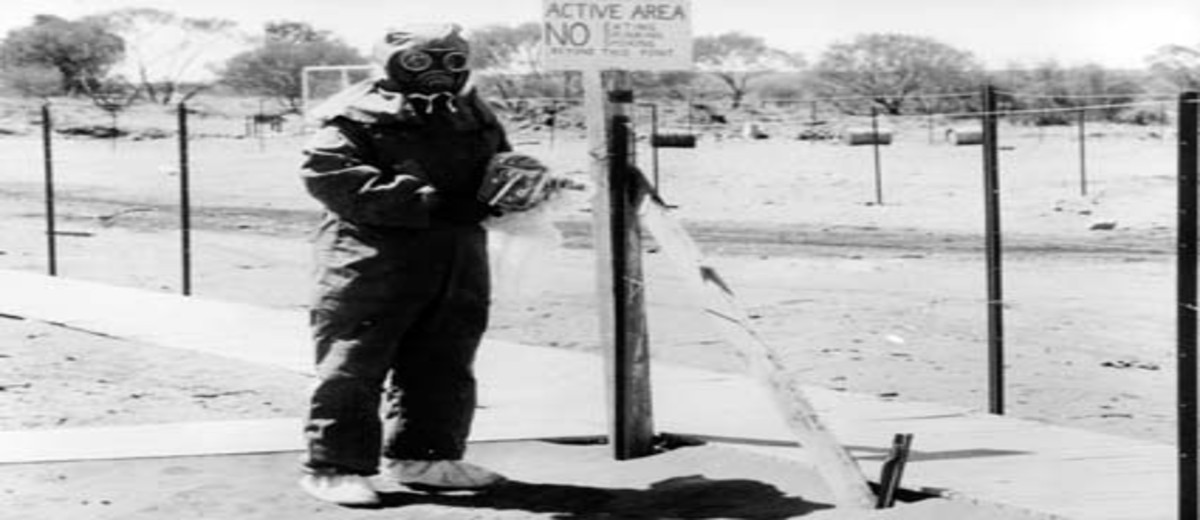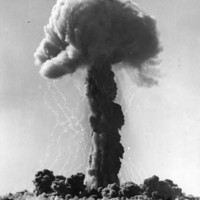The main site for joint Australian–British nuclear weapons tests in Australia lies 800 kilometres north-west of Adelaide on the southern edge of the Great Victoria Desert. The original prohibited area of approximately 3200 square kilometres encompassed Maralinga village and test sites on the Tietkens Plain – a region presumed to be sufficiently remote, secure and barren for such activities. At its height in the late 1950s the well‑appointed settlement had a population of 2000.
Nuclear Testing at Maralinga
Nine atomic explosions were detonated at Maralinga: two in October 1953, four in September/October 1956, and a final three in September/October 1957. There were also some 700 ‘minor’ trials involving radioactive materials before Maralinga closed in 1967 after a British-financed clean-up (Operation Brumby).
Public Opinion and Contamination
Maralinga enjoyed strong support from both the Menzies and Playford governments, and contemporary public opinion, except on the political left, endorsed the strategic necessity of the tests. Despite some scientific disquiet at the time about long-term effects of possible radioactive fallout over south-eastern Australia, it was not until the 1980s that rising public protests led to a federal royal commission convened by Mr Justice James McClelland. This body examined safety procedures during the tests, and later disposal of toxic materials. It found that some areas remained seriously contaminated, the worst being Taranaki, the site of the last explosion in October 1957, and also of 12 ‘Vixen B’ trials in 1960–63 that dispersed about 22 kilograms of plutonium. Some of this plutonium was repatriated, some buried, and the rest harrowed into the topsoil during Brumby. The half-life of plutonium-239 is 24,110 years, and as little as one microgram in the lung can cause cancer.
Rehabilitation and the Continuing Effects of the Tests
In December 1993 the British and Australian governments agreed to provide more than $100 million for a thorough rehabilitation. All polluted top-soil was to be removed and deeply buried, and some burial pits stabilised by in situ vitrification (ISV) – the electrical melting of the debris into a glassy rock.
In March 2000 the site was declared ‘clean’ and fully habitable, with the exception of 120 square kilometres at Taranaki that can be traversed but is not safe for occupation. Ownership of Maralinga, including the village, was to be transferred to traditional owners, the Tjarutja people. However, controversy about the adequacy of the clean-up has continued, particularly after the abandonment of ISV and the subsequent adoption of deeper reburial.
Persistent assertions that some Australian ex-servicemen involved in the Maralinga tests have suffered consequential health problems, and that Indigenous peoples were harmed, especially by an alleged ‘Black Mist’ after the 1953 blast, have come to nothing. The royal commission concluded that ‘because of the deficiencies in the available data, there is now little prospect of carrying out any worthwhile epidemiological study of those involved in the tests nor of others who might have been directly affected by them’, and so most compensation claims have foundered.
Blakeway, D and S Lloyd-Roberts, Fields of Thunder (London: George Allen & Unwin, 1985)
McClelland, JR, Royal Commission into British Nuclear Tests in Australia (Canberra: Australian Government Public Service, 1985)
Millikan, R, No Conceivable Injury (Melbourne: Penguin, 1986)
Morton, P, Fire Across the Desert: Woomera and the Anglo-Australian Joint Project 1946-1980 (Canberra: AGPS Press, 1997)
Symonds, JL, A History of British Atomic Tests in Australia (Canberra: Australian Government Public Service, 1985)




Add your comment